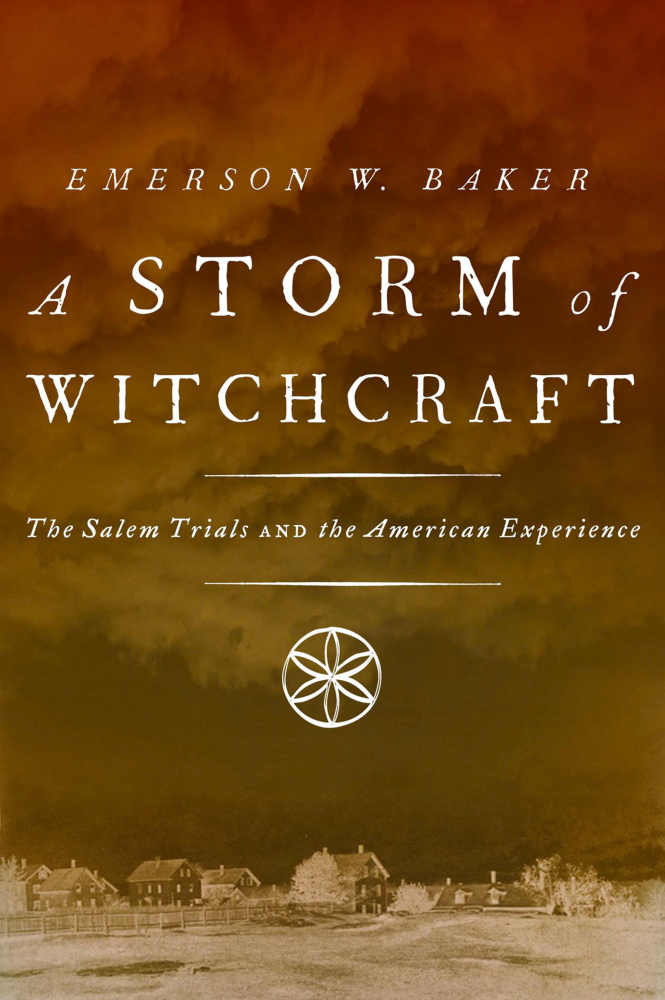By almost any measure, Emerson W. Baker’s new history, “A Storm of Witchcraft,” is a masterpiece. Few volumes pass the exacting standards needed to be described as such. Baker’s does.
A professor of history at Salem State University from York, Baker has written several related books, including “The Devil of Great Island: Witchcraft & Conflict in Early New England” (2007) and “The New England Knight: Sir William Phips” (1998). Certainly few individuals understand Colonial life in the Northeast better and few, if any, explain events so convincingly and with such clarity and documented detail.
From the all-embracing title to Baker’s carefully argued conclusions, the reader is given the where, who, what and why of the 1692 Massachusetts trials. If you think you knew all about the “crying out against” during which 150 Bay Colonists were accused and 25 suffered death for dealing with the devil, odds are you are wrong.
This thesis takes on and, to this reviewer’s satisfaction, disproves the long-standing belief that the trials were a flamboyant non-event as described by the great 20th century historian Perry Miller, who wrote that they had “no effect on the ecclesiastical or political situation, it does not figure in the institution or ideological development.” Baker blows this statement out of the water, calling the trials “a pivotal turning point in American history.”
Though footnoted and framed in a scholarly way – after all, this is from Oxford University Press – the book is written in Baker’s characteristically readable style. He plunges the reader into a time of brutal warfare, religious and political uncertainty, and with the younger generation of Puritan leadership back in legislative power after the brief royalist dominion of New England.
It was also a time when “nearly everyone believed in the existence of witches” in league with the devil, who had been created by God as a challenge to man.
Hex signs were part of daily New England life. Though an occasional witch had been hanged since the Puritan arrival, it was rare.
Though beautifully told in nine concise chapters, the book cannot cover all of the many cases that led to the witchcraft disaster. Surprisingly, perhaps, the near destruction of Maine, then part of Massachusetts, by the Indians and French played a major role. The buffer zone to the Northeast was gone. English refugees resented their loss of status. Many Puritan leaders of the new generation felt themselves unworthy of the founding generation. Fewer were able to sign the covenant with God.
Governor Phips, with the backing of the Bay Colony, founded the new Court of Oyer and Terminer and filled it with judges who had worked for and then turned on the Dominion of New England. None of the judges was old-line Puritan-elect. Baker seems to have a working knowledge of each judge, accuser and accused – and the baggage each carried. Amazingly, all the men and women who went along with their accusers and confessed survived, even the slave Tituba. It was the people who did not confess or did not recognize the court who were executed or severely punished. Indeed, Puritan intellectual Cotton Mather published a defense of the trials and spectral evidence (“I saw my neighbor dancing with Satan”), when writing about the trials was otherwise forbidden. Baker proves a cover-up by the Puritan establishment that was quickly seen through and led to the demise of the theocratic state.
The book follows the thread of the trials from Mather to Hawthorne to Arthur Miller. Anyone interested in the Salem witch trials and the shaping of the nation should treat themselves to this book.
William David Barry is a Portland historian who has authored or co-authored books including “Maine: The Wilder Half of New England” and “Deering: A Social and Architectural History.”
Copy the Story LinkSend questions/comments to the editors.



Success. Please wait for the page to reload. If the page does not reload within 5 seconds, please refresh the page.
Enter your email and password to access comments.
Hi, to comment on stories you must . This profile is in addition to your subscription and website login.
Already have a commenting profile? .
Invalid username/password.
Please check your email to confirm and complete your registration.
Only subscribers are eligible to post comments. Please subscribe or login first for digital access. Here’s why.
Use the form below to reset your password. When you've submitted your account email, we will send an email with a reset code.